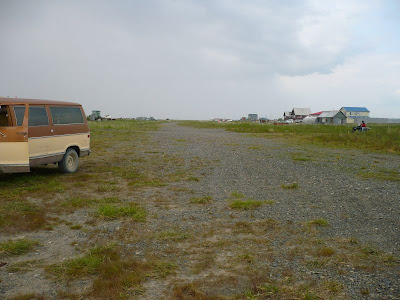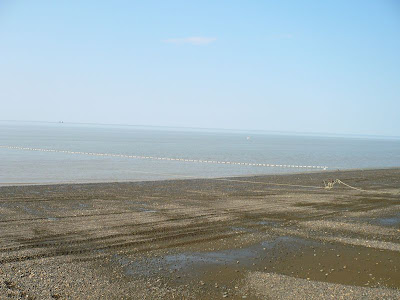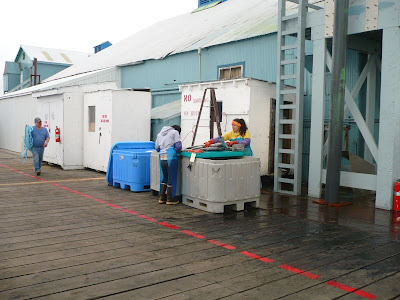My parents left Thursday night for West Virginia, and I left Friday night after work for Ekuk. Of course, first I had to buy a 7-day commercial crewmember license, some raingear, boots, and a sleeping bag. I packed up all my clothes and gear, and picked up some groceries for Tonya and Rich.
Ekuk is a small community on the southern edge of Nushagak Bay. I think it might actually be on the Bristol Bay, which is what the Nushagak Bay empties into. Dillingham is on the north shore of Nushagak Bay, on the narrow end near the Wood and Nushagak Rivers. Ekuk is across on the south shore and around the end of a couple of points. (Straight across from Dillingham is a village called Nushagak, and then you can often see Clark's Point farther out. Ekuk is around on the other side of Clark's Point.) No one lives in Ekuk year round, except for the winter watchman at the cannery. Everyone else just goes there to fish. Some of the cabins are pretty nice, but others are a step above a trailer. It doesn't really matter. If you're there, you're there to fish.
To get to Ekuk, you fly or take a boat. That's about it. Besides me, Tonya's friend Jeanine and her dog Karma were also going for the weekend. We caught a ride on Bristol Bay Air, which is run by the lone pilot of the operation, John Paul. He's a good pilot with a well-maintained aircraft. But it's a small plane.

Samara dropped me at the airport at around 5pm, and I met up with Jeanie, her dog, John Paul and his other passenger. We walked through the gate and loaded our gear right onto the plane.

John Paul gassed up, we all jumped in, and he taxied around to the runway. Pretty soon, he throttled up and we were into the air.

It was neat to see Dillingham from the air as we took off. I didn't mind flying in the small plane at all. There's plenty to see when you're at 700 feet and cruising, and it felt perfectly safe. It's a ten or fifteen minute flight across the bay. There was plenty to see.
I spotted the hospital at the end of Kanakanak Road, then boats in the bay headed out for fishing.

All these little boats run drift nets to catch fish out in the bay.

We flew past Nushagak, with its giant white orthodox cross on the hillside.

Then we passed over Clark's Point, which has quite a few people by the name of Clark still living there. There were a lot of boats just off the shore there.

Pretty soon we started banking hard as we flew over Ekuk. I could see houses and cabins dotting the beach as we banked, and although I didn't realize it at the time, I could see the runway as well.

We went out and flew over the beach, and could see people down there fishing as the tide went out. Quickly, we banked back around parallel to the beach and started coming in for a landing. All I could see was tall grass out either window as we touched down on a gravel runway about as wide as a two-lane road.

It even narrowed and curved towards the end. Not a big runway, for sure.


After we jumped out, we unloaded our gear from the nose and tail of the plane, along with Tonya's boxes of groceries. We wandered over to the cabin, but no one was home. I went back and ferried everything from the plane to the cabin. (It was only a couple hundred yards.) Inside the cabin was a note that they had fish and we were welcome to come down to the beach.

We got our gear on, and I got Jeanie to take a picture of me in my clean raingear. This was the last time I bothered to wear the jacket all weekend, but I wore the bibs every time I went down to the beach.
 I took a look around Ekuk, but there's not a lot to see.
I took a look around Ekuk, but there's not a lot to see.

Once we had our gear on, no one was driving by to hitch a ride with. Instead, we started walking. Tonya had told me they were only about a half mile down the beach. She lied. They were three or four miles. Thankfully when we got part of the way there, someone stopped and gave us a ride. We sat in the back of a dump-back fishing truck with our boots in icy water. (It keeps the fish fresh.)
When we got down to the site, they had already picked all of the fish out of the net and we ready to throw them into the truck. We helped them do that and then headed back up to camp.
At this point, I should probably stop and explain a little about how set-net commercial salmon fishing works. You get a site permit, then you get some nets. The nets are 50 fathoms long and about six feet wide. Along one side of the net is a line with floats spaced along it, called a cork line. On the other side is a long heavy line called a lead line. At either end is a bridle, which is basically a two-by-four that keeps the net spread open. You hook rope to the bridle at either end. Just like subsistence fishing, you have an anchor out in the ocean and two sets of pegs up on the beach. When you want your net in the water, you put rope on either end of your net, which runs down from the pegs to the net, then from the net through the anchor, and back up the beach to the other pegs. Fish swim into the mesh of the net, get caught by the gills, and then sit there in the water until you pull the net out. You pull the neat by loosening both ends of your lines from the pegs and hooking a cable clamp onto one rope and pulling the net in. When you want your net in the water, you pull the other rope to run it back out.
Most people use a pickup truck to pull their gear in and out of the water. Not Rich. Rich uses a Maruka tracked vehicle.

He can run it way out into the mud without sinking in and it will pull anything. Gear will break before his Maruka does. It makes it much easier than using a pickup truck to pull gear.
Once the gear is on the beach, everyone goes along the net with a small hook like a bent nail with a rubber handle. You use that to pull on the holes in the net and get the fish out. Salmon have gills and little fins under their bodies near the gills, and they tend to get stuck in the net right there. They can't get pulled out if the mesh gets stuck in the gills, so you need the hook to pull the mesh away from the gill as you work the fish out. Sometimes a fish gets so far into the net that it's easier to just pull it through. I like those.
Anyway, you pull the fish out and then throw it up above the net onto the beach in piles. Once they're all out of the net, you load them into the back of pickup trucks (preferably with a dump bed), put some slush ice and water over them, and drive up to the cannery to make a delivery.


The cannery offloads the fish into hoppers and weighs them. You get a ticket with the weight and your permit info, and they pay you later based on the price per pound.
The fishing season is very dependent on the escapement of salmon. You have to make sure there's enough salmon going up river to spawn for next year, so the Department of Fish and Game tells you when you can and can't fish. They're called openings. When it's open, you fish. Except, of course, that in Ekuk there's one damn cannery. So if they get overwhelmed, or if they're not happy with the quality of fish, they may tell you to stop fishing. You have to do it, pretty much, because if they won't take the fish, then there's nowhere to put them and you can get a serious ticket from the wildlife troopers for wasting fish. A lot of fishermen would love to have the foreign markets come in to buy fish, since they'd pay more and could handle more volume, but so far the fishery is closed to foreign markets.
So we helped load fish that first night and then delivered them. Then it was back to the cabin for dinner of BLTs. They eat pretty good at fish camp. We went to bed before too late, and we were back up at 3am to set more gear. You get two tides a day, and the tides dictate when you can fish. I didn't have to get up, but I was there to learn, so I accompanied Rich, Tonya and their crewmember Kali down to the beach. I had to ride in the back of the truck and it was a little cold, but I learned how to set gear.
Then it was back to bed for about 5 hours, and then we got up to fish again. That morning when we pulled the gear, there was about 850 pounds of fish in the net. That wasn't bad, and it gave me a pretty easy introduction to picking fish and loading. After we pulled gear, we set it right back out again and then went back for breakfast.
A little later in the morning, we went back down to pull the gear again. Here's everyone getting ready.


Sometimes you pull it on the incoming tide and sometimes you pull it when the tide is going out. It's harder to pull on an incoming because as you pick fish, the tide is coming in, so you have to be fast before the tide covers the whole beach. It comes in right up to the bluff at Rich's fishing spot.
When we got there, the fish were hitting the net like crazy. Rather than pull the gear right away, we sat down and watched them swimming into the net. Rich and Tonya drove back up and brought down a second truck and some snacks. We relaxed and just let the fish do their thing.
Here are some pictures of our morning fishing adventure.





It was low tide then, and once the tide had turned a little, Rich pulled in the gear and we picked 3200 pounds of fish. (Well, to be fair, that included a pile of fish that fell out of the broken tailgate at the next site down, which one of the crewmembers there told us we were welcome to.) That was more of a workout, but I was getting better at picking fish.




 I went with Rich to do the delivery on this load.
I went with Rich to do the delivery on this load.




We went back up to the cabin and relaxed for a little while and had dinner. Rich set gear again a bit later.
It was a good thing that we did relax a little. I ate both porkchops and steak, along with rice and cabbage salad. I went back for thirds.
At around 9pm, we went back down to check the gear. The fishing was looking pretty good. Rich was running the Maruka and Kali and I were standing by to put the cable clamp on the line to pull in the net. Tonya was standing by to loosen the rope at the other end. When we went to pull the gear, everything went a little crazy. The bridle snapped as Rich went to pull, then when we were running around trying to get the clamp on the cork line to pull the gear in, it slipped off a couple of times. The cable clamp swung around and got caught inside the track of the Maruka and Rich ran it over with the inner wheels a few times before we got it out. It was broken then, and we had to scramble for another cable clamp. Finally, Kali and I jumped into the surf, and I held up the cork line while she popped the cable clamp on it. We pulled the gear up onto the beach a bit at a time that way until all of the net was above the water line. I was panting and out of breath by the time we were done.
That's when we realized why gear was breaking. There were a lot of fish in the net.



Rich estimated 10,000 pounds at first, but that estimate went up a few times as we picked at the net for 3 hours to get all the fish out. Luckily it was overcast and we had pulled the gear up into the runoff from the creek nearby, which meant the fish sat on wet gravel and didn't bake in the sun. It was after midnight when we got all the fish out of the net. We seemed to pick forever, even though we had one of Rich's cousins, Garth, as well as Tonya, Rich, Jeanie, the 1o-year-old twins Caiti and Shari, Kali and me all picking.



Another one of Rich's cousins came along and brought his truck, so that we had 4 trucks full of fish to take to the cannery. That was good. Throwing all those fish into the backs of the trucks probably took another hour. When all the fish was offloaded, we had pulled 15,326 pounds of fish on a single pull of the net. That's the second biggest pull Rich has ever made and he's been fishing with his family in Ekuk since he was a toddler. I'm glad I was there for it.
We celebrated with some drinks and sitting around chatting for a while afterwards, and didn't get to bed until 5am.

Thankfully the cannery had cut us off from fishing for a bit, so we all slept in Sunday morning. Then Jeanie and I hung around all day waiting for our ride home, since we didn't know who we were going to ride with at first, then once John Paul agreed to take us, he had other flights to make, then fish to pull at 8:30pm before he could fly.
When we finally got onto the plane, it was probably 10:30. John Paul was in a hurry and said he had six people to take back to Dillingham. Three of us, the dog and John Paul took off from Ekuk and landed almost immediately on the runway in Clark's Point. We all got out, unloaded our gear and waiting will John Paul flew back to Ekuk and got more people. Turns out that one of them was a pilot for Grant Aviation, who had a slightly bigger (small) plane at Clark's Point. He loaded Jeanie, her dog, and two guys from National Geographic out here to write a story about fishing, and me into the plane and we flew from Clark's Point to Dillingham.
Samara had been waiting for a little while by then, unfortunately. Worse yet, I couldn't smell myself apparently. As soon as I got in the car, she said I stank like rotten fish. She had to pull over and barf almost right away. I felt pretty bad, but I jumped in the shower and washed my clothes as soon as I got home.
I was pretty worn out Monday at work. I almost fell asleep at my desk. I have a lot of sore muscles and some sunburn as well. Nevertheless, I got a fishing experience that was at least as hard as what those guys do on Deadliest Catch, according to Rich, who has fished crab before. It was worth the pain and smell. I really enjoyed myself.




















